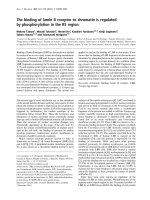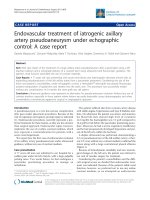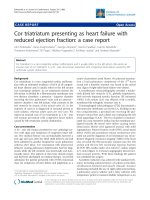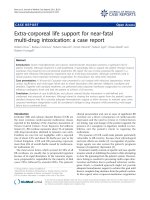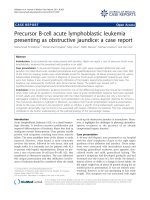Báo cáo y học: " Peritoneal dissemination of prostate cancer due to laparoscopic radical prostatectomy: a case report" pptx
Bạn đang xem bản rút gọn của tài liệu. Xem và tải ngay bản đầy đủ của tài liệu tại đây (1.59 MB, 4 trang )
JOURNAL OF MEDICAL
CASE REPORTS
Peritoneal dissemination of prostate cancer due
to laparoscopic radical prostatectomy: a case
report
Hiyama et al.
Hiyama et al. Journal of Medical Case Reports 2011, 5:355
(5 August 2011)
CASE REP O R T Open Access
Peritoneal dissemination of prostate cancer due to
laparoscopic radical prostatectomy: a case report
Yoshiki Hiyama
1
, Hiroshi Kitamura
1*
, Satoshi Takahashi
1
, Naoya Masumori
1
, Tetsuya Shindo
1
, Mitsuhiro Tsujiwaki
2
,
Tomoko Mitsuhashi
2
, Tadashi Hasegawa
2
and Taiji Tsukamoto
1
Abstract
Introduction: Peritoneal dissemination with no further metastases of prostate cancer is very rare, with only three
cases reported in the available literature. We report the first case of iatrogenic peritoneal dissemination due to
laparoscopic radical prostatectomy.
Case Presentation: A 59-year-old Japanese man underwent laparoscopic radical prostatectomy for clinical
T2bN0M0 prostate cancer, and the pathological diagnosis was pT3aN0 Gleason 3+4 adenocarcinoma with a
negative surgical margin. Salvage radiation therapy was performed since his serum prostate-specific antigen
remained at a measurable value. After the radiation, he underwent castration, followed by combined androgen
blockade with estramustine phosphate and dexamethasone as each treatment was effective for only a few months
to a year. Nine years after the laparoscopic radical prostatectomy, computed tomography revealed a peritoneal
tumor, although no other organ metastasis had been identified until then. He died six months after the
appearance of peritoneal metastasis. An autopsy demonstrated peritoneal dissemination of the prostate cancer
without any other metastasis.
Conclusion: Physicians should take into account metastasis to unexpected sites. Furthermore, we suggest that
meticulous care be taken not to disseminate cancer cells to the peritoneum during laparoscopic radical
prostatectomy.
Introduction
Peritoneal dissemination with no further metastases of
prostate cancer is very rare with, to the best of our
knowledge, only three cases reported in the available lit-
erature. There has not yet been a report of a patient
undergoing surgical treatment that might have resul ted
in iatrogenic dissemination. We report the first case of
iatrogenic peritoneal dissemination due to laparoscopic
radical prostatectomy (LRP).
Case presentation
A 59-year-old Japanese man presented to our urology
clinic with lower urinary tract symptoms. His serum
prostate-specific antigen (PSA) level was 9.5 ng/mL. A
digital rectal examination revealed a hard induration of
his prostate. He had no personal or familial history of
malignant disease. A prostate biopsy was performed and
showed Gleason score 3+4 adenocarcinoma of the pros-
tate. Computerized tomography (CT) and bone scinti-
graphy showed no metastasis. He was referred to our
Department of Urology for treatment of cT2bN0M0
prostate cancer, and underwent LRP. The operation was
performed with a transperitoneal approach. The patho-
logical diagnosis was pT3aN0 Gleason score 4+4 adeno-
carcinoma with a positive surgical margin.
After the operation, his PSA level dropped to 0.7 ng/
mL at its lowest, and so salvage radiation therapy with
50 Gy was carried out. His serum PSA level initially
dropped to 0.5 ng/mL b ut began to increase, to 3.5 ng/
mL, shortly after. Medical cas tration was then started.
The therapy was effecti ve for 24 months, after which he
needed additional anti-androgen agents (bicalutamide
and flutamide) and estramustine phosphate because of
an increase in his PSA level. Sixty-six months after the
prostatectomy (PSA 76.3 ng/mL) dexamethasone was
administered, an d provided the minimal PSA level, 0.58
* Correspondence:
1
Department of Urology, Sapporo Medical University School of Medicine,
Sapporo, Japan
Full list of author information is available at the end of the article
Hiyama et al. Journal of Medical Case Reports 2011, 5:355
/>JOURNAL OF MEDICAL
CASE REPORTS
© 2011 Hiyama et al; licensee Bi oMed Central Ltd. This is an Open Access article distributed under the t erms of the Creative Commons
Attribution License (http://creativecommons.o rg/licenses/by/2.0), which permits unrestricted use, distribution, and reproduction in
any medium, provided the original work is properly cited.
ng/mL, 18 months after the initial administration. How-
ever, his PSA level increased again, so the endothelin
receptor antagonist was replaced by dexamethasone f or
12 months with no effect on his PSA level. Thereafter
dexamethasone was administered again, and his PSA
decreased from 340 ng/mL to 118 ng/mL.
After that, his PSA level continued to increase without
any metastasis visible on CT or bone scans. Our pa tient
could not undergo chemotherapy with docetaxel
because of complicati ons with heart failure and intersti-
tial pulmonary disease. At a ge 69, 114 months after the
LRP, CT showed a peritoneal tumor that was considered
to be a peritoneal metastasis (Figure 1). His PSA level
was 168 ng/mL, and no other organ metastasis was
found. Five month s later, metastases to the mesentery
were revealed by CT. The peritoneal metastases pro-
gressed with a large amount of ascites, and our patient
died 120 months after the LRP.
An autopsy revealed 4000 ml of clear yellow ascites
and numerous nodules in his peritoneum, mesentery
and omentum (Figure 2). These were pathologically
diagnosed as dissemination of prostate cancer. No other
metastasis was detected in any organ in the pathological
evaluation. There was no port-site metastasis, during
follow-up or at autopsy.
Discussion
Metastases from prostate cancer to the bone, lymph
nodes and lung are common events, but peritoneal
metastasis is very rare and seldom reported in the litera-
ture. Even at autopsy, peritoneal metastasis is unusual,
whereas bone (90%), lung (46%), liver (25%), pleural
(21%) and adrenal (13%) metastases are reported in
some large autopsy series [1]. Only three cases with
peritoneal metastasis from prostate cancer have been
reported (Table 1) [2-4]. Although these three cases had
no opportunity for tumor implantation, our patient
might have incurred iatrogenic dissemination to the
peritoneum during the LRP. To our knowledge, this is
the first case of iatrogenic peritoneal dissemination due
to LRP. The main causes of such metastases a ppear to
be tumor behavior and laparoscopy-related factors [5,6],
including gas ambience [7], surgical manipulation [6]
and overuse of ultrasonic scissors [8] . Alternatively, the
dissemination may have b een due to poor su rgical tech-
nique, since this was only the second case of LRP in our
institute. Lee et al. reported that poor technique
increased port-site metastasis risks [9] and growing
experience decreases this incidence [10]. However, the
possible existence of peritoneal metastases at the LRP
cannot be ruled out, since his serum PSA level did not
fall under the lowest measuring limit during the local
therapies.
The pathological diagnoses of the previous three cases
were Gleason 4 and/or 5 adenocarcinoma with or with-
out mucinous adenocarcinoma (Table 1). Two of them
demonstrated good responses to hormone therapy [2,3],
and the combination of docetaxel with estramustine
phosphate was effective in the other case [4]. Our
patient experienced 120-month survival after the initial
treatment, although no therapy was available without
dexamethasone when the peritoneal metastasis was
detected. Thus the standard strategy should be consid-
ered as a treatment for peritoneal metastasis from pros-
tate cancer.
Conclusion
Peritoneal dissemination of prostatic carcinoma is a very
rare occurrence. Meticulous procedures during LRP
Figure 1 An abdominal CT scan shows mesenteric metastases
(arrows) and ascites (A) due to peritoneal dissemination.
Figure 2 Multiple nodules in the mesentery at autopsy.
Hiyama et al. Journal of Medical Case Reports 2011, 5:355
/>Page 2 of 3
should be perfor med to avoid a dissemination of cancer
cells to the peritoneum. The treatment should be per-
formed in accordance with the standard strategy for
prostate cancer, including hormone therapy and
chemotherapy.
Consent
Written informed consent was obtained from the patient
for publication of this case report and accompanying
images. A copy of the written consent is available for
review by the Editor-in-Chief of this journal.
Abbreviations
CT: computerized tomography; LRP: laparoscopic radical prostatectomy; PSA:
prostate-specific antigen.
Author details
1
Department of Urology, Sapporo Medical University School of Medicine,
Sapporo, Japan.
2
Department of Surgical Pathology, Sapporo Medical
University Hospital, Sapporo, Japan.
Authors’ contributions
HY, HK, ST, NM, TS and TT were involved in conception, design and
interpretation. HY and HK wrote the manuscript. MT, TM and TT performed
the histological examination and provided the histopathological images. All
authors read and approved the final version submitted.
Competing interests
The authors declare that they have no competing interests.
Received: 24 January 2011 Accepted: 5 August 2011
Published: 5 August 2011
References
1. Bubendorf L, Schopfer A, Wagner U, Sauter G, Moch H, Willi N, Gasser TC,
Mihatsch MJ: Metastatic patterns of prostate cancer: an autopsy study of
1,589 patients. Hum Pathol 2000, 31(5):578-583.
2. Kehinde EO, Abdeen SM, Al-Hunayan A, Ali Y: Prostate cancer metastatic
to the omentum. Scand J Urol Nephrol 2002, 36(3):225-227.
3. Brehmer B, Makris A, Wellmann A, Jakse G: [Solitary peritoneal
carcinomatosis in prostate cancer]. Aktuelle Urol 2007, 38(5):408-409.
4. Zagouri F, Papaefthimiou M, Chalazonitis AN, Antoniou N, Dimopoulos MA,
Bamias A: Prostate cancer with metastasis to the omentum and massive
ascites: a rare manifestation of a common disease. Onkologie 2009,
32(12):758-761.
5. Wittich P, Marquet RL, Kazemier G, Bonjer HJ: Port-site metastases after CO
(2) laparoscopy. Is aerosolization of tumor cells a pivotal factor? Surg
Endosc 2000, 14(2):189-192.
6. Tsivian A, Sidi AA: Port site metastases in urological laparoscopic surgery.
J Urol 2003, 169(4):1213-1218.
7. Kuntz C, Wunsch A, Bodeker C, Bay F, Rosch R, Windeler J, Herfarth C: Effect
of pressure and gas type on intraabdominal, subcutaneous, and blood
pH in laparoscopy. Surg Endosc 2000, 14(4):367-371.
8. Iacconi P, Bendinelli C, Miccoli P, Bernini GP: Re: A case of Cushing’s
syndrome due to adrenocortical carcinoma with recurrence 19 months
after laparoscopic adrenalectomy. Re: Re: A case of Cushing’s syndrome
due to adrenocortical carcinoma with recurrence 19 months after
laparoscopic adrenalectomy. J Urol 1999, 161(5):1580-1581.
9. Lee SW, Southall J, Allendorf J, Bessler M, Whelan RL: Traumatic handling
of the tumor independent of pneumoperitoneum increases port site
implantation rate of colon cancer in a murine model. Surg Endosc 1998,
12(6):828-834.
10. Lee SW, Gleason NR, Bessler M, Whelan RL: Port site tumor recurrence
rates in a murine model of laparoscopic splenectomy decreased with
increased experience. Surg Endosc 2000, 14(9):805-811.
doi:10.1186/1752-1947-5-355
Cite this article as: Hiyama et al.: Peritoneal dissemination of prostate
cancer due to laparoscopic radical prostatectomy: a case report. Journal
of Medical Case Reports 2011 5:355.
Submit your next manuscript to BioMed Central
and take full advantage of:
• Convenient online submission
• Thorough peer review
• No space constraints or color figure charges
• Immediate publication on acceptance
• Inclusion in PubMed, CAS, Scopus and Google Scholar
• Research which is freely available for redistribution
Submit your manuscript at
www.biomedcentral.com/submit
Table 1 Summary of reported cases of peritoneal metastasis of prostate cancer
Authors Age Initial
PSA
(ng/
mL)
Gleason score Initial
TNM
Treatment before
detection of the peritoneal
metastasis
PSA at the
diagnosis of
peritoneal
metastasis (ng/
mL)
Treatment after
the diagnosis of
peritoneal
metastasis
Follow-up after
the diagnosis of
peritoneal
metastasis
Kehinde
et al. [2]
76 365 4+4, mucinous
adenocarcinoma
T3(?)
N0M1
- 365 Hormone therapy 18 months, AED
Brehmer
et al. [3]
75 42 4+5 T3N0M1 - 42 Hormone therapy 14 months, AED
Zagouri
et al. [4]
75 33 4+5 T×N0M0 Hormone therapy for 72
months
74 Docetaxel +
estramustine
phosphate
18 months, AED
Present
case
69 9.5 4+4 T3aN0M0 Radical prostatectomy,
salvage radiotherapy, and
hormone therapy for 89
months
168 Palliative 6 months, DOD
AED, alive with evidence of disease; DOD, dead of disease
Hiyama et al. Journal of Medical Case Reports 2011, 5:355
/>Page 3 of 3
